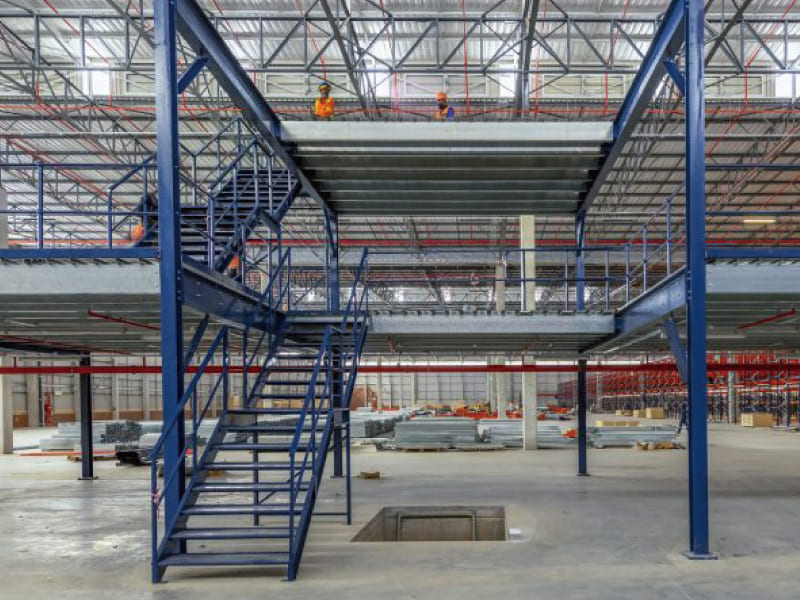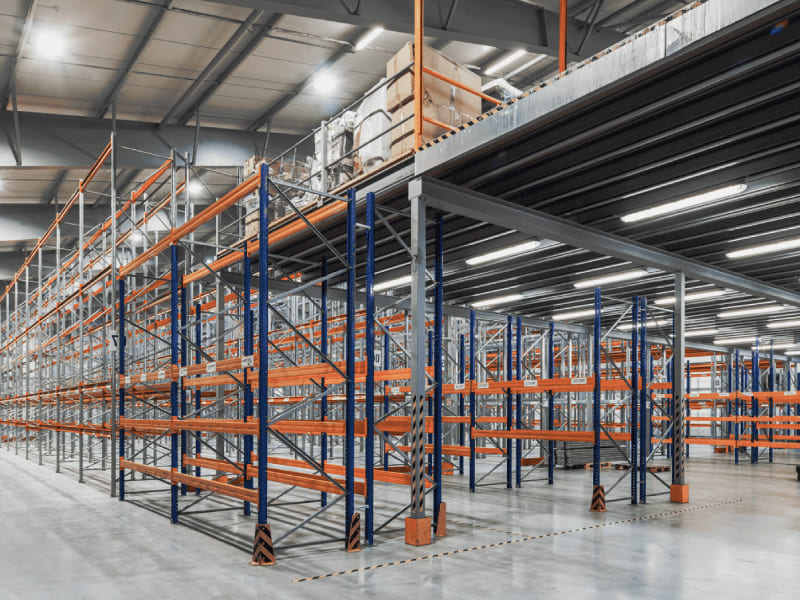Like temporary floors, Mezzanine floors are used to increase the space of existing areas. It can be easily removable and reusable. Mezzanine floors are widely used in the industrial realm, educational institutes, and storage yards.
A mezzanine floor is an intermediate floor between the main floors of a building, typically not included in the building’s official floor count.
The key materials used in constructing mezzanine floors include steel, aluminum, and fiberglass, with flooring options ranging from wood product finishes to heavy-duty steel grating.
Due to their modular nature, mezzanine systems are usually free-standing, meaning they can be dismantled and relocated if necessary.

There are several types of mezzanine floors, each designed to serve different purposes. Here are the most common ones used for storage:
Structural mezzanine floors are standalone structures made from steel beams and columns. These systems are highly customizable, allowing businesses to tailor them to specific requirements. Structural mezzanines can support heavy loads and accommodate various functions, from storage to production and office spaces.
Benefits:
Rack-supported mezzanine floors are built directly on top of existing pallet racking systems, providing an efficient way to maximize vertical space without additional structural support. This type of mezzanine is commonly used in warehouses and distribution centers where palletized goods are stored.
Benefits:
Shelf-supported mezzanines are similar to rack-supported systems but are built on top of shelving units instead of pallet racks. These systems are ideal for storing smaller items that need to be organized on shelves, such as tools, parts, or retail products.
Benefits:
4. Roll-Formed Mezzanine Floors
Roll-formed mezzanine floors are constructed using lightweight steel components that are cold-formed into shape. These systems are typically used for light to medium-duty storage applications. The construction process is faster than that of structural mezzanines, making them a popular choice for businesses that need quick solutions.
Benefits:
Mezzanine floors are widely used in warehouses and distribution centers to maximize storage space. These facilities often have high ceilings, and mezzanines allow businesses to make full use of the vertical cube. By installing mezzanine floors, businesses can create additional levels for storing inventory, improving order fulfillment efficiency.
In retail environments, mezzanines are used to increase both selling space and storage capacity. Retailers can display products on the mezzanine level, while the ground floor is used for high-traffic sales areas. This setup is particularly beneficial for businesses with limited floor space in prime retail locations.
Manufacturing facilities often require additional space for production, packing, or sorting. A mezzanine floor can provide this space without the need for a costly facility expansion. By separating different production processes on multiple levels, businesses can improve workflow and operational efficiency.
Many businesses use mezzanine floors to create office spaces within warehouses or factories. These offices can be built either above or below the mezzanine deck, depending on the facility’s layout. This allows companies to integrate administrative functions into the same building as their production or storage operations.

1. Maximizes Vertical Space
One of the most significant advantages of mezzanine floors is their ability to utilize unused vertical space. In facilities with high ceilings, mezzanine floors provide an opportunity to create additional storage or workspace without expanding the building’s footprint. This vertical optimization is especially valuable in urban areas where horizontal space is limited.
Installing a mezzanine floor is far more cost-effective than relocating to a larger facility. Businesses can increase their usable space without the expense of purchasing or renting new premises. Additionally, mezzanine floors can be dismantled and relocated, offering flexibility as the business grows.
Mezzanine floors are highly customizable, allowing businesses to tailor the structure to their specific needs. Whether it’s for storage, production, or office space, mezzanines can be designed to meet load requirements, access needs, and other operational considerations.
4. Increased Operational Efficiency
By creating additional levels for storage or production, mezzanine floors can improve workflow and operational efficiency. For example, businesses can designate one level for storage and another for packing or sorting, streamlining operations and reducing the time it takes to fulfill orders.
5. Quick Installation
Compared to constructing new facilities or expanding existing ones, mezzanine floors can be installed relatively quickly. This minimizes disruption to ongoing operations, allowing businesses to continue functioning while the mezzanine is being built.
While mezzanine floors can offer benefits in certain cases, there are several factors businesses need to consider before installation:
The load capacity of a mezzanine floor is crucial, especially in storage applications where heavy goods are involved. Businesses need to ensure that the floor can support the intended weight, including both static and dynamic loads.
In many regions, mezzanine floors must comply with building regulations, particularly concerning fire safety. For example, mezzanine floors used in retail spaces must be fire-rated, and the stairs and handrails must meet public access standards. Businesses should consult with local authorities to ensure compliance.
Access to the mezzanine floor is another important consideration. Depending on the facility’s layout and the mezzanine’s purpose, businesses may need to install stairs, lifts, or conveyors to transport goods and personnel between levels.
The choice of floor finish will depend on the mezzanine’s intended use. For storage applications, businesses may opt for heavy-duty steel grating, while office spaces may require wood or carpeted finishes. The floor finish should be durable and suitable for the environment in which the mezzanine will be used.
The purpose of Facility construction is all about what your business is meant for, if you have no problem, don't fix it. If your predictable future growth merits, thus expansion should be taken into account.
Overcome the efficiency plateau with automated storage and retrieval systems.
Schedule a consultation with Vison for a comprehensive view.
Derechos de autor
© 2024 Jiangsu Vijing Logistics Technology Co., Ltd. Reservados todos los derechos.
 RED SOPORTADA
RED SOPORTADA